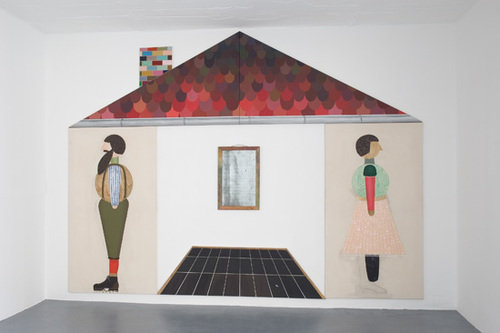Juliana Ortiz
dal 8/10/2008 al 7/11/2008
Segnalato da
8/10/2008
Juliana Ortiz
Emmanuel Post, Leipzig
The Opposite of Slapstick. The artist' works often deal with the domestic; with where to sleep, what to cook or bake, with what to hang on the wall. She paints the living room carpet, the bed, the wallpaper and the telephone, the ceiling lamp in her parents' holiday home and the macrame' ornament on the wall.

Juliana Ortiz's works often deal with the domestic; with where to sleep, what to cook or bake, with what to hang on the wall. She paints the living room carpet, the bed, the wallpaper and the telephone. She paints the ceiling lamp in her parents' holiday home and the macramé ornament on the wall. She paints her parents' living room and their house viewed from outside. She paints the swing in the garden with marks of its use left in the snow.
In Teppich (Carpet), the picture's outer shape is also the outline of the object represented. Thus, Ortiz thematises the pictorialness of the thing as well as the thingness of the picture. The perspectival tilting of the carpet, resulting in a trapezoid form, coupled with a brushstroke that imitates the textural materiality of a real carpet, creates an imagined space to be inhabited by the viewer's imagination. The picture acts as a bridge into the interior of the viewer's mind.
As in Teppich, patterns appear in many of Ortiz's works. Patterns – either woven, knotted, or painted in trompe l'oiel as if they were woven or knotted – mediate between opposites. Hovering between the original and the replica, between the representational and the abstract, the pattern connects the domestic and the industrial. Patterns function equally well as replicas or as concrete art. The pattern refers both to the 19th century arts and crafts movement as to serial production methods found in modern and contemporary art.
Above all, weaving away quietly can be very comforting. Immersing oneself in uniform action offers recovery from the pressures of always having to come up with something new and original, whilst also assuring that the picture is growing and growing and growing…
The pattern reconciles tedium with creativity. Moreover, patterning is analogous to processes found in nature. Some species naturally lack a thick epidermis, such as the quiver fly larva, which needs to protect its soft abdomen with a skirt of sticks and little stones, in turn a form resembling handmade vases from the 1970s.
Ortiz's paintings always look "handmade". Serial structures appear neither industrial, nor is Ortiz striving to achieve a particularly masterly rendering. She carries out her artistic inventions directly, deriving her techniques more from the world of hobby than from the academy. There is no final refinement stage. This engenders an art, which is not lavish or compelling because of how it is executed, but rather because of the curiosity that precedes its execution.
Some of the depicted objects are built by the artist herself, as improvised solutions for everyday problems - even if their function sometimes remains obscure. Haken (Hook), for instance, could be used to hang up clothes, yet, it could also be used by birds for resting after a long and strenuous flight. However, it might also be a utensil from the world of Liesel and the Naturbursche (Nature lad) who seem awkwardly stranded between object and living creature, yet proudly uphold their lack of function.
Ortiz herself often appears in her pictures as if she had turned her back on humanity – in situations variously recalling fairytales, or, literally, visions - through which she respectively moves awake, asleep or sleepwalking.
Apart from the portraits of her family, Ortiz is the only other figure in the pictures. Or at least the only human figure – for bed, chair and curtain rail all seem strangely alive. But this is by no means unsettling; the objects are not enemies as in slapstick, but rather affable beings that seek to surround their creator, as if there were mutual approval between (wo)man and material.
Paule Hammer, 2006
Translated from the German by Oliver Kossack
Juliana Ortiz (*1976) will be showing her most recent works on canvas at the exhibition It matters to me. Her 'self-portraits' convey a significant development in her artistic process through depictions of isolated things taken from her everyday surroundings in her studio. Her large canvases present direct, immediate renditions with fundamental simplicity; the objects appear in a puzzling narrative or playfully surreal way, estranged from their original functions.
Opening: 7 pm, Thursday, October 9, 2008
Emmanuel Post
Windmuhlenstrasse 31b - Leipzig
Wed - Sat, 2 - 6 pm
Free admission



